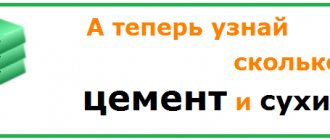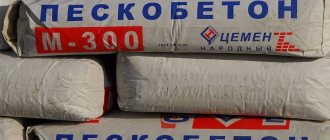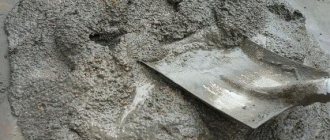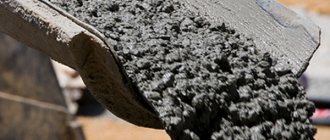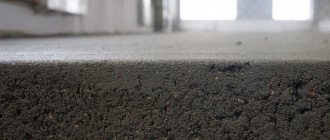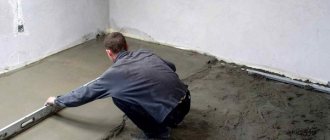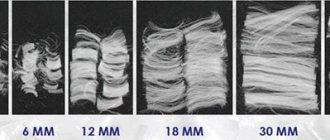The most common way to level the floor in a room is to use a sand and cement screed (CPS). But it is worth noting that the preparation process will take a long time. Only in the case of durable floors can a cement-sand screed be used, since the weight of this material is quite large. If you make a layer thickness of 1 cm, then the weight of one square meter will be about 20 kg. But in practice it is made 3 cm thick, no less. If this layer is smaller, the screed will begin to crumble and eventually crack. Let's consider what sand-cement consumption should be used for successful covering.
Calculation of the amount of material and proportions
There are two types of mixtures used in construction: regular and ready-made. Conventional mortar is used to level not only the floor, but also to level the walls. The simplest standard solution of self-leveling floor screed is prepared using M300 grade cement and clean sand, which has a medium-grained fraction. The third component is water.
All components are mixed as follows: take 1 part of cement and add 1.5 - 3 parts of medium-grained sand. But the amount of water is calculated based on how many kilograms of cement were taken. For 1 kg of cement take 0.5 liters of water.
Now on the construction market there are a lot of modifiers and fillers that are added to the sand-cement mixture. Why do they do this? To increase frost resistance, reduce the time for hardening, and also reduce the likelihood of cracks and delamination.
Conventional mortars, like backfill for dry floors, are sold on construction markets. Their use will reduce the time spent on repairs. In such mixtures, all components are ideally selected and in ideal proportions. The manufacturer produces each type for one or another type of connection to the floor.
The video shows the consumption of PCB per 1 m2 of screed:
The weight depends on the proportion of the components that are included in the composition: on the amount of water, on the power of the screed and on the brand of cement used. The maximum thickness of the screed usually does not exceed 7 cm, otherwise the foundation of the house will have to be strengthened so that it can withstand such a large load. Depending on the thickness of the layer, choose the type of bond:
- the screed will be connected to the rough foundation and to the walls;
- will not be associated with any structures;
- an insulating layer is used, as a result it will be a floating layer.
Find out how to calculate the foundation for a house made of aerated concrete.
Here you can familiarize yourself with the composition of aerated concrete adhesive.
Dimensions of gas silicate blocks: .
How to properly mix leveling compounds
How to properly mix leveling compounds
If the mixture is diluted incorrectly, no amount of tricks will help make a high-quality coating. The main mistake beginners make is adding more water than indicated in the instructions. A more liquid composition spreads faster, but the strength and durability of the floor is reduced several times. In addition, peeling, cracks, and other defects may appear on the coating.
To properly prepare the solution, you will need water with a temperature of at least +10 degrees, a convenient container for mixing, a drill with an attachment and a dry mixture. Strictly adhering to the specified proportions, pour the mixture into water and mix for 3-4 minutes with a mixer attachment. Then leave the solution for 3 minutes to ripen and mix again for a minute. The result should be a homogeneous mass without lumps, liquid enough to spread without additional leveling. If the technology is followed, the filling process will not cause difficulties, and the mixture consumption will not exceed the calculated one.
| Name | Drying time | Layer thickness | Consumption kg/m2 | Price RUR/kg |
| Horizon universal | 3-7 days | 2-100 mm | 3-4 | 236/20 |
| BOLARS | 4 hours | 2-100 mm | 3-4 | 239/20 |
| Vetonit 3000 | 4 hours | 1-5 mm | 1,5 | 622/25 |
| Palafloor-303 | 4-6 hours | 2-100 mm | 1,4-1,6 | 308/20 |
| GLIMS-S-Level | 24 hours | 2-5 mm | 3 | 478/20 |
| Perfecta Multilayer | 2-3 hours | 2-200 mm | 7-14 | 312/20 |
| xton | 3-4 hours | 6-100 mm | 14-16 | 256/20 |
| Name. Short description | Packaging kg | Consumption kg/mm/m2 | Price | Strength MPa | Layer thickness in mm |
| ALFAPOL VP - finishing self-leveling self-leveling floor M200 F200 Pk5 W12 on a cement base | 25 | 1,75 | 375-471 | 20 | 2-40 |
| REAL Floor leveler, High-quality dry cement-based mortar | 25 | 1,7 | 360 | 20 | 2-80 |
| Bergauf BODEN ZEMENT MEDIUM, self-leveling floor for the final leveling of horizontal surfaces, ideal for further installation of any floor coverings (ceramic tiles, parquet, carpet, linoleum) | 25 | 2 | 289-324 | 20 | 6-60 |
| Forbo Eurobond 915, fast-hardening self-leveling floor, low shrinkage, self-leveling, quick-drying. Suitable for heated floors. For indoor use, incl. in damp areas. Withstands the load from furniture on casters. | 25 | 1,7 | 405 | 20 | 3-50 |
| Petromix PS, for leveling floors on concrete and other hard substrates in dry, damp and damp areas. Serves as a base for floor coverings (parquet, ceramic tiles, textile carpets, plastic coverings, linoleum, etc.) | 25 | 1,5 | 441-471 | 25 | 2-30 |
| The foundation will be T-42 Nipline, a self-leveling, high-strength, moisture-resistant, non-shrinking leveler on a cement-sand base using special chemical additives. | 25 | 1,7 | 342-433 | 25 | 3-30 |
| Ceresit CN 178, for the manufacture of screeds operating under conditions of low and moderate mechanical loads, incl. with constant exposure to moisture (in residential and public premises, on exploited roofs, balconies, terraces, open areas, etc.), during external and internal work, in civil and industrial construction. | 25 | 2 | 370 | 35 | 5-80 |
| Vetonit 4100 cement-based mixture for leveling concrete floors indoors | 25 | 1,6 | 520-537 | 20 | 2-30 |
| vetonit 4150, suitable for quickly leveling concrete floors and creating screeds in residential buildings, offices and public buildings. It is used for repairs and new construction under various types of floor coverings. Used in “Warm Floor” designs | 25 | 1,6 | 520-550 | 20 | 2-30 |
| Berghauf BODEN ZEMENT FINAL, self-leveling cement-based flooring for perfectly smooth surfaces. For rooms with normal and high humidity (bathroom). | 25 | 1,8 | 435-490 | 20 | 0,5-5 |
Types of screeds
- Semi-dry.
- Self-leveling.
- Sand concrete.
- Dry.
Semi-dry
The semi-dry screed contains cement, sand and fiber fibre. The name comes from the fact that a minimal amount of water is used here. Typically, such a screed is laid using special machines. Semi-dry is highly durable. It is used in cases where it is necessary to level large surfaces with a mixture layer thickness of more than 5 cm. The pros and cons of semi-dry floor screed are described in detail here.
Self-leveling
Self-leveling or self-leveling screed. The third name is self-leveling self-leveling floor. The mixture contains cement and sand. But it is worth knowing that fine sand is used here. Plasticizers and hardeners are also added here. When laying, the mixture is well distributed over the entire surface.
But in this case you will need a lot of water. It is used as a finishing layer. It is also used if you need to correct any defects or irregularities. The thickness of the self-leveling floor usually does not exceed 30 mm. And, despite this, this type of screed has high strength.
Sand concrete
Sand concrete is used in cases where no other methods can cope with the floor. The composition includes Portland cement, coarse sand, fine washed sand and granite chips. Follow the link to read which sand concrete is best for floor screed.
A little more water is used in the preparation of sand concrete than in a semi-dry mixture for floor screed. Sand concrete screed has very high strength. But behind this lies a rather complicated installation of the coating. Alignment is done manually. For sand concrete to dry completely, you need to wait quite a long time - about a month.
Dry
Dry screed does not contain water. Typically used when you need to level a wooden floor or make a high floor. The composition includes expanded clay, which indicates low strength. Here are the pros and cons of dry floor screed.
"Ceresit"
In conclusion, we can imagine a ready-made mixture that you can safely purchase if you don’t want to understand and process information on this matter.
The consumption of Ceresite self-leveling floor is only 1.2 kg per square meter. With a floor thickness of 1-1.5 mm.
Marking the mixture for sand-cement screed (CPS)
To create a cement-sand screed (CSS), you need to select the right components. In turn, for this you need to know the markings. When marking cement, you can see the letter M and a number. For example, M200 means that 1 cubic meter can withstand a load of 200 kg.
In order to prepare the solution yourself, you need to use the M400 marking. But in the case of a ready-made mixture, you need to pay attention to other numbers. A solution designated M150 or M200 indicates two options for proportions. The first option: we used the marking of M600 cement, which was mixed with sand in a ratio of 1 to 3. The second option: M400 cement was mixed with sand in a ratio of 1 to 2. The cement was also marked with an additional abbreviation. As part of the topic, it is useful to read about what dry universal mixture m 150 is.
- Sulfate-resistant cement is designated SS. It is usually used where temperature differences are high.
- Portland slag cement or ShPC – this cement contains many impurities.
- PL – cement contains a very large amount of additives in the form of plasticizers that increase the plasticity of the material.
- Hydrophobic cement is resistant to moisture and frost.
- Waterproof cement is labeled as WRC. This mixture sets well even in water.
Calculation of screed (self-leveling floor) consumption if the base is sloped
The task
First, let's look at the picture with the original problem. Let's assume that we have a room (or other premises) of a given size of 10x10 meters (in the figure there is a volumetric view and a side view).
Let's assume that we need to raise the floor by 200 mm:
Among other things, we see that the base has a slope from wall to wall from 0 to 100 mm. So how to calculate the amount of material? The task is not the most trivial and mathematics is already rushing to help us.
How to calculate the required concrete consumption
Knowing the proportions of cement and sand for floor screed, as well as other components, it is necessary to correctly calculate the consumption. For example, it is necessary to cover a floor of 100 sq.m. with concrete screed. Based on the following parameters: layer thickness 5 mm, ratio of sand to cement solution 4 to 1. Now you need to find out the volume of the composition. It is necessary to multiply the area of the room by the thickness of the cement screed. It turns out 5 cubic meters. To prepare the mixture, you need to add water. It will account for about half of the composition. Therefore, we subtract this amount, leaving 2.5 cubic meters.
Now you need to find out how much cement you need to take. When choosing a proportion of 1 to 4, you need to add two shares, the result is the number 5. Divide the remaining 2.5 by 5, resulting in 0.5. This means that for 0.5 cubic meters you will need one share of cement. And in order to find out how much sand you need, you need to subtract 0.5 from 2.5. The result is this: for 100 square meters you need to take 0.5 cubic meters of cement and 2 cubic meters of sand. But if you buy material on the market, you need to know that it is sold in packages. They offer to buy cement in packages of 25 kg and 50 kg. That is, it is better to make calculations in kilograms. 1300 kg weighs approximately one cubic meter of cement. As a result, 0.5 needs to be multiplied by 1300 and we get 650 kg. You will need 13 packages of cement, 50 kg each.
If we talk about sand, it is heavier. One cubic meter weighs approximately 1600 kg. And for 2 cubic meters there will be 3200 kg of sand.
The video shows a cement-sand mixture for floor screed:
Features of the material
Screed is used in almost all apartments, so this type of work is one of the most common. It is laid under the facing covering. Thus, the thermal insulation of the room increases, which is very important in modern apartments.
The screed also acts as a leveling base. Nowadays it’s rare to find even relatively flat floors, and many facings require a perfectly flat surface underneath. In such cases, cement screed is irreplaceable.
Also, a cement-sand floor screed protects the base of the floor, strengthening it. This layer is not afraid of any mechanical damage and loads. It will be quite difficult to get rid of it, so when replacing the layer you will have to work carefully.
The durability of the material goes hand in hand with eternity. The service life of the screed can outlive several generations of residents. But this is only if it is installed correctly; it is easy to spoil the mixture if you do not follow the technology for its preparation.
The material is not afraid of water. If the integrity of the layer is not compromised, then even a spilled bucket will not become a problem and cause flooding of neighbors. This is especially important for the kitchen or bathroom, where the risk of water leakage is quite high. The base will absorb huge amounts of water without damage. The screed installation process is not complicated. Even a beginner can do high-quality work. But it requires painstakingness, it is important to check the mixture and not deviate from the installation instructions, otherwise you risk damage to both the screed and the facing coating.
In terms of price, the materials are relatively cheap and affordable for everyone. There are also disadvantages to cement-sand mortar. First of all, this concerns water. When preparing, the solution is wetted with copious amounts of water, which can lead to leakage if a layer of waterproofing is not laid under the screed. During the process of pouring the solution, a lot of dirt is formed. It is difficult to work with the mixture, since the bags weigh 50 kg.
Leveling the composition is also not so easy, and if the work is done incorrectly, this will lead to the futility of the work done and the money spent.
Another disadvantage of the solution is its final weight. It puts significant pressure on the base. And it cannot be used in wooden houses. To facilitate the construction, expanded clay is placed under the solution.
All cement-based solutions take a very long time to dry. Complete curing may take a month, increasing repair time. In addition, if you need to repair the screed, you will have to dismantle the old layer and fill in a new one in most cases.
All of the above applies to mixtures installed using the wet method. There is also a variant of semi-dry screed, which differs fundamentally from wet screed. Semi-dry screed is made on the basis of the same DSP. But it dries much faster than the wet method. Within a week you can begin cladding. The process is cleaner as opposed to wet.
Calculation of flow rate with slope. Start.
Now, having slightly refreshed our memory on the method of calculating simple options, we will begin to count complex ones. The fundamental principle for solving any complex problem is to “break a complex problem into several simple tasks (problem decomposition).”
When the great French sculptor Auguste Rodin was asked by his students what the art of a sculptor consists of, Auguste Roudin replied: “I take a block of marble and cut off everything unnecessary from it.”
Let's take advantage of this.
We previously calculated that if our base were perfectly flat, we would need 40 tons of mixture (screed, sand concrete, self-leveling floor). This is our “block of marble”. And we have the “extra” in this composition, that same unfortunate bias that we must calculate and remove. How to calculate?
Step 1.
As shown in the figure below, draw a line from the top of the slope parallel to the floor:
Step 2.
Next, we see that we have a base with a height of 100 mm. How many screeds will be required for a height of 100 mm, if we imagine that slope No. 2 (in the figure) does not exist (i.e. we have a perfectly flat floor)? We already remembered how to calculate it: (area 100 m2) * (height 100 mm) * (consumption 2 kg) = 20,000 kg (or 20 tons).
Step 3.
It is easy to notice that at the base we see two (No. 1) and (No. 2) absolutely identical triangles, which divide our volume into two equal parts. Thus, if we spend 20 tons of mixture for the entire volume, then 10 tons for half, respectively. Thus, we now know that in order to fill a volume equal to a triangle (No. 1) or (No. 2) we will need 10 tons.
Step 4.
In the previous step, we calculated the excess volume (triangle No. 2) equal to 10 tons, now, knowing the total volume and the volume of the “extra” part, we calculate how much material we actually need. Having 40 tons (this is the entire volume for a given height of 200 mm) minus the “extra” 10 tons that would have been spent filling the slope, we get (40t - 10t) = 30 tons. This is our answer.
